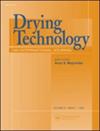使用QBD方法设计、开发和评估喷雾干燥的氟比洛芬缓释聚合物纳米颗粒以控制炎症
IF 2.7
3区 工程技术
Q3 ENGINEERING, CHEMICAL
引用次数: 0
摘要
本文章由计算机程序翻译,如有差异,请以英文原文为准。
Design, development, and evaluation of spray dried flurbiprofen loaded sustained release polymeric nanoparticles using QBD approach to manage inflammation
Abstract Spray-dried Flurbiprofen (FLB) loaded polymeric nanoformulation using Eudragit L 100 and Ethylcellulose. They were optimized and evaluated. This study determined drug release (%) and encapsulation efficiency (%) by developing a nanoparticulate system using the design of experiment (DoE) approach. FLB is slightly soluble in water; it dissolves slowly and has a low oral bioavailability. FLB-loaded polymeric nanoparticles were produced by solvent evaporation and Spray drying technology. In this research, nanoparticle formulation was prepared by screening and optimization by approaching two different statistical methods (Plackett-Burman and Central composite Designs). The polymeric nanoparticles were evaluated for various characteristics, including drug release, percentage of encapsulation efficiency, X-ray diffraction (X-RD), surface morphology, and Fourier transform infrared (FTIR) spectroscopy. Based on the X-RD analysis, it was found that the drug was successfully incorporated into the polymeric nanoparticles. As a result of nanoparticles containing FLB, % Drug release values were found to be nearly 85-90% increased while % EE was observed in the range of 79-89%. An excellent sustained release, i.e., 14 h, is possible by combining Ethylcellulose (EC) and Eudragit L 100 (ED-100) polymers. The results are beneficial in identifying the ideal formulation parameters for effective encapsulation. Abbreviations: FLB: Flurbiprofen; API: Active pharmaceutical ingredient; DR: Drug release; EE: Encapsulation efficiency; DoE: Design of experiment; X-RD: X-ray diffraction; FTIR: Fourier transform infrared spectroscopy.; PVA: Polyvinyl alcohol; EC: Ethylcellulose; EUGD: Eudragit L 100; NPs: Nanoparticles; PBD: Placket- Burman Design; CCD: Central Composite Design; CMV: Critical method variables; GIT: Gastrointestinal track; SLN: Solid lipid nanoparticles; NLC: Nanostructured lipid carriers; NSAID: Nonsteroidal anti-inflammatory drug; BCS: Biopharmaceutical classification system; PS: Particle size; PDI: Polydispersity Index; ZP: Zeta potential; FE-SEM: Field emission scanning electron microscopy; 2D: 2 Dimensional; 3D: 3 Dimensional GRAPHICAL ABSTRACT
求助全文
通过发布文献求助,成功后即可免费获取论文全文。
去求助
来源期刊

Drying Technology
工程技术-工程:化工
CiteScore
7.40
自引率
15.20%
发文量
133
审稿时长
2 months
期刊介绍:
Drying Technology explores the science and technology, and the engineering aspects of drying, dewatering, and related topics.
Articles in this multi-disciplinary journal cover the following themes:
-Fundamental and applied aspects of dryers in diverse industrial sectors-
Mathematical modeling of drying and dryers-
Computer modeling of transport processes in multi-phase systems-
Material science aspects of drying-
Transport phenomena in porous media-
Design, scale-up, control and off-design analysis of dryers-
Energy, environmental, safety and techno-economic aspects-
Quality parameters in drying operations-
Pre- and post-drying operations-
Novel drying technologies.
This peer-reviewed journal provides an archival reference for scientists, engineers, and technologists in all industrial sectors and academia concerned with any aspect of thermal or nonthermal dehydration and allied operations.
 求助内容:
求助内容: 应助结果提醒方式:
应助结果提醒方式:


